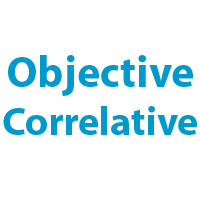What is Objective Correlative?
Objective Correlative is a term popularized by T.S. Eliot in his essay on 'Hamlet and His Problems' to refer to an image, action, or situation – usually a pattern of images, actions, or situations – that somehow evokes a particular emotion from the reader without stating what that emotion should be.

Explaining his view Eliot says, "The only way of expressing emotion in the form of art is by finding an 'objective correlative'; in other words, a set of objects, a situation, a chain of events which shall be the formula of that particular emotion; such that when the external facts, which must terminate in sensory experience, are given, the emotion is immediately evoked' it is from this point of view that he finds Hamlet defective and “an artistic failure.” He also says that in Macbeth Shakespeare is successful in finding an 'objective correlative' to express the emotions of Macbeth and Lady Macbeth. Eliot says: “If you examine any of Shakespeare’s more successful tragedies, you will find this exact equivalence; you will find that the state of mind of Lady Macbeth walking in her sleep has been communicated to you by a skilful accumulation of imagined sensory impressions; the words of Macbeth on hearing his wife’s death strike us as if given the sequence of events, these were automatically released by the last even in the series. The artistic “inevitability” lies in this complete adequacy of the external to the emotion; and this is precisely what is deficient in Hamlet. Hamlet (the man) is dominated by an emotion which is inexpressible because it is in excess of the facts as they appear ……Hamlet is up against the difficulty that his disgust is occasioned by his mother but that his mother is not an adequate equivalent for it; his disgust envelops and exceeds her. It is thus a feeling which he cannot understand; he cannot objectify it, therefore remains to poison life and abstract action. None of the possible actions can satisfy it: and nothing that Shakespeare can do with the plot can express Hamlet for him.
According to Eliot, when writer fails to find objective correlatives for the emotions they wish to convey, readers or audiences are left unconvinced, unmoved, or even confused. Eliot applied his theory of 'Objective Correlative' to Shakespeare’s play Hamlet (1602), arguing that it is an “artistic failure” because occurrences in the play do not justify Hamlet’s depth of feeling and thus fail to provide convincing motivation.
Objective Correlative was the term first used in a mid-nineteenth-century art lecture given by the American poet and painter Washington Allston, but later it was redefined by T.S. Eliot and became widespread among the critical circles specially the New Critics.
The phrase 'Objective Correlative' and the concept lying there in have gained great currency since then. It has become so popular with the people that critics like Wimsatt and Brooke have gone to the extent of saying that “the phrase objective correlative has gained a currency probably far beyond anything that the author could have expected or intended.” The phrase has been used by Eliot to express how emotion can be best expressed in poetry and it is a part of his impersonal theory of poetry concentrating not on the poet but on the poetry. The theory of impersonal art implies that greater emphasis should be laid upon the work of art itself as a structure. Eliot has learnt from the French symbolists that emotion can only be evoked; it cannot be expressed directly. Eliot’s theory was also anticipated by Ezra Pound in 'The Spirit of Romance.' Pound admitted that in the ideographic process of using material images to suggest immaterial relations, the poet has to be as impersonal as the scientists: “Poetry is a sort of inspired mathematics, which gives us equations, not for abstract figures, triangles, spheres, and the like, but equations for the human emotion."
Published on 28 Feb. 2018 by Kedar Nath Sharma
